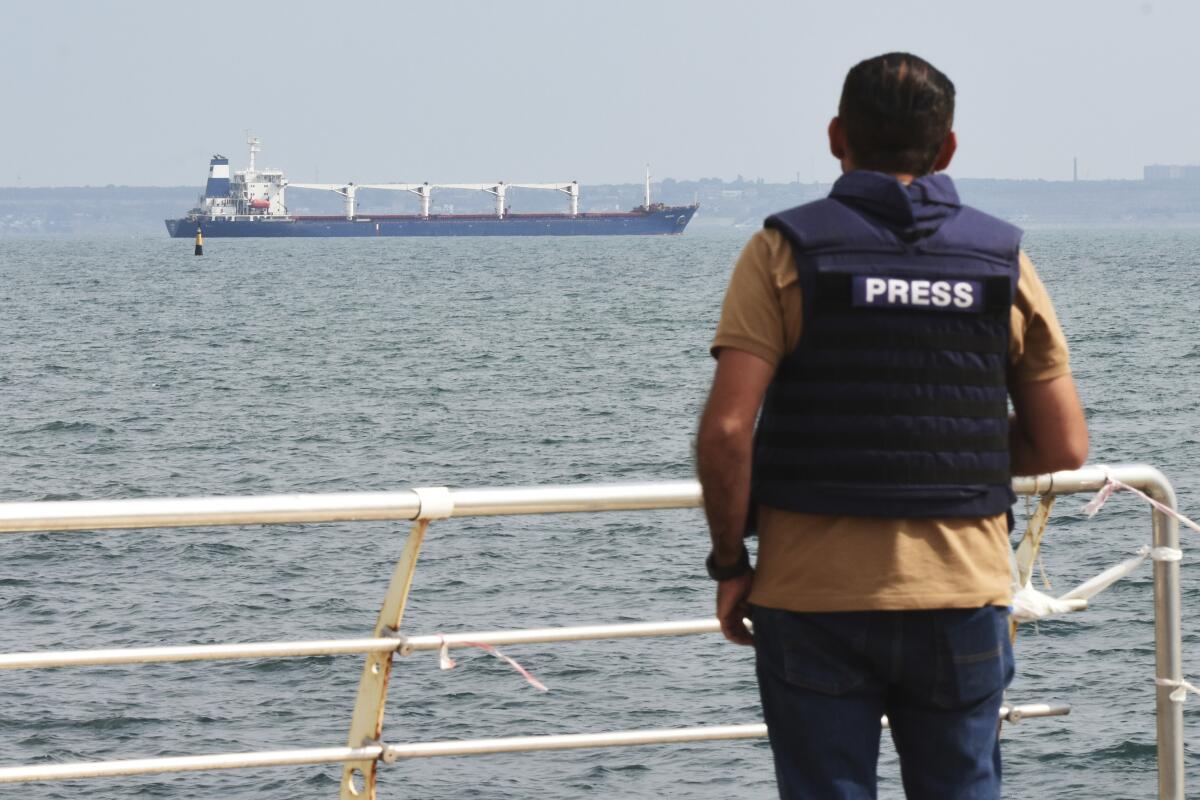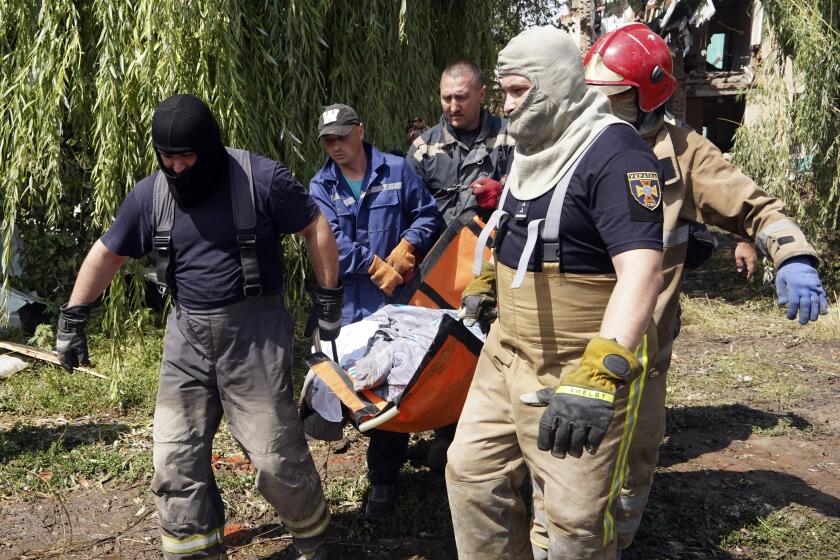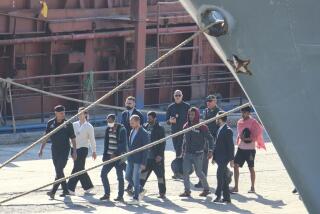First shipment of Ukraine’s grain is a test of wartime deal with Russia

- Share via
KYIV, Ukraine — The first cargo ship to leave Ukraine since Russia invaded its neighbor more than five months ago was off the coast of Bulgaria on Tuesday as it headed toward Istanbul, putting to the test an agreement signed last month between Moscow and Kyiv that aims to help alleviate a global food crisis.
The Sierra Leone-flagged Razoni, which set sail from the Ukrainian port of Odesa on Monday, is expected to reach Istanbul early Wednesday after hitting bad weather that slowed its progress, according to Turkish Rear Adm. Ozcan Altunbulak, a coordinator at the joint center established to oversee the grain shipments.
Russian, Ukrainian, Turkish and United Nations officials are to inspect the ship after it anchors in Istanbul. The inspections are part of a U.N.- and Turkish-brokered deal to shift Ukrainian grain stockpiles to foreign markets and ease the mounting world food crisis.
As part of the July 22 agreement on shipments, which include exports of Russian grain and fertilizer, safe corridors through the mined waters outside Ukraine’s ports were established.
By early afternoon Tuesday, the Razoni was about 120 miles north of Istanbul, according to the Marine Traffic vessel tracker.
Altunbulak said “preparations and planning” were continuing for other ships to leave Ukraine’s ports, but he did not provide details.
The old imperial city of Odesa is infused with Russian history. But war has cemented its Ukrainian identity.
The situation in the Black Sea remains tense. Some mines have reportedly become detached and are floating free, and in a sign of mistrust between the warring sides, Ukrainian President Volodymyr Zelensky has urged international partners to keep a close eye on Moscow’s compliance with the deal.
The safe corridors are supposed to allow more ships to leave from Ukraine’s ports. At Odesa, 16 more vessels, all blocked since Russia’s invasion Feb. 24, are awaiting their turn, Ukrainian authorities say. There was no immediate word on when a second ship might set sail.
Kremlin spokesman Dmitry Peskov said Turkish President Recep Tayyip Erdogan’s planned visit to Moscow on Friday for talks with Russian President Vladimir Putin would offer a “good opportunity to review the efficiency of the mechanism” for resumed grain exports.
The more than 26,000 tons of corn on board the Razoni, destined for Lebanon, will make barely a dent in what the World Bank last week called “rising food insecurity” across the world.
Ukrainian forces are scaling up attacks to reclaim territory in the south, forcing Russia to divert fighters from the main battlefront in the east.
“Record-high food prices have triggered a global crisis that will drive millions more into extreme poverty,” the World Bank’s latest food-security update said, blaming the war in Ukraine, global supply-chain problems and the COVID-19 pandemic.
Most of the roughly 20 million tons of grain stuck in Ukraine since the start of the war is to feed livestock, according to David Laborde, an export on agriculture and trade at the International Food Policy Research Institute in Washington.
Only 6 million tons of that trapped grain is wheat, and just half of that is for human consumption, Laborde said. He said Monday’s departure of a large shipment of corn from Ukraine to Lebanon is actually chicken feed.
“A few ships leaving Ukraine is not going to be a game-changer,” he said.
News Alerts
Get breaking news, investigations, analysis and more signature journalism from the Los Angeles Times in your inbox.
You may occasionally receive promotional content from the Los Angeles Times.
But the voyage of the Razoni has at least raised hopes that the global food situation could improve. Ukraine and Russia are major world suppliers of wheat, barley, corn and sunflower oil. The fertile Black Sea region has long been known as the breadbasket of Europe, and Ukraine is a major exporter of wheat to developing countries in Africa, the Middle East and Asia.
The shipping developments came against a backdrop of continued fighting, especially in southern and eastern Ukraine.
Moscow’s forces stuck to their familiar pattern of bombarding areas they don’t hold, with Ukrainian officials reporting that the Russian shelling killed at least three civilians in eastern areas overnight.
In the Donetsk region at the forefront of the Russian offensive, the bombardments targeted towns and villages, especially Bakhmut, which has taken the brunt of recent shelling.
Ukraine used U.S.-supplied HIMARS multiple rocket launchers to take out a bridge in the occupied Kherson region, a supply route for Russian forces.
Donetsk Gov. Pavlo Kyrylenlo said that “the Russians are leveling Bakhmut with a massive barrage from the ground and from the air.”
“The shelling of Bakhmut is continuing around the clock, leaving civilians little chance to survive,” Kyrylenko said in televised remarks.
The U.S. said it was sending an additional $550 million worth of military aid to Kyiv. Defense Secretary Lloyd J. Austin III said in a tweet late Monday that the package included 75,000 rounds of artillery ammunition and more ammunition for the American-built HIMARS multiple-rocket launchers, which have given Ukrainian forces an advantage on the battlefield.
More to Read
Sign up for Essential California
The most important California stories and recommendations in your inbox every morning.
You may occasionally receive promotional content from the Los Angeles Times.













